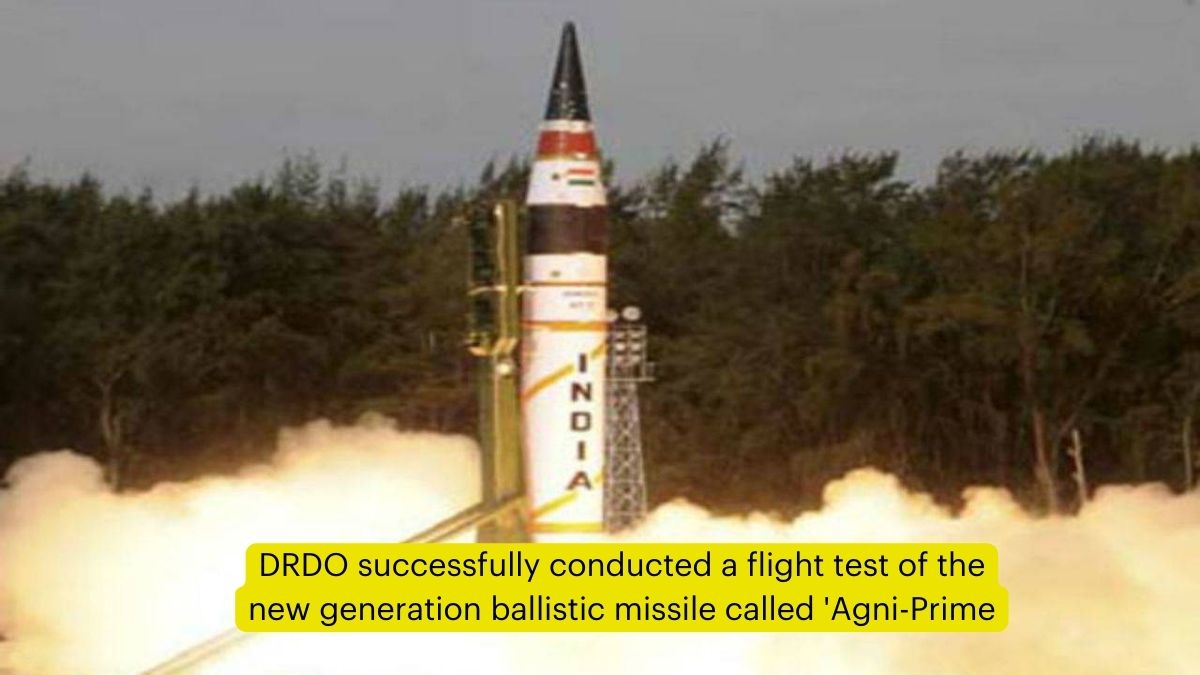The Defence Research and Development Organisation (DRDO) and India’s Strategic Forces Command (SFC) have successfully conducted a flight test of the new generation ballistic missile called ‘Agni-Prime’. The test occurred at Dr APJ Abdul Kalam Island, off Odisha’s coast. The data was captured by several range sensors placed at different locations, including two downrange ships placed at the terminal point. The launch was witnessed by the Chief of Defence Staff, Chief of Strategic Forces Command, and other senior officials from DRDO and the Indian Army.
About Agni-Prime
Agni-P, also known as Agni-Prime, is a medium-range ballistic missile (MRBM) developed by DRDO. It is equipped with nuclear capabilities and is considered the successor to Agni-I and Agni-II missiles in the SFC’s operational service. Agni-Prime has a strike range of 1,000 to 2,000 km and incorporates technological advances from Agni-IV and Agni-V.
The missile has undergone significant upgrades, such as a composite motor casing, maneuverable reentry vehicle (MaRV), improved fuels, and advanced navigation and guidance systems. Agni-Prime is completely built using composite material, which offers advantages like being lightweight and having better strength and flexibility in design and production.
Agni-Prime is a two-stage, solid-fueled, surface-to-surface missile that is road-mobile and transported via truck. The missile is launched using a canister, similar to the country’s first intercontinental ballistic missile (ICBM), Agni-V, with a strike range of over 5,000 km. Agni-Prime is a ballistic missile with dual navigation and guidance systems.
Features of Agni-Prime
Agni-Prime is a new missile that looks similar to Agni-III but has reduced weight by half. It is designed to replace older generation missiles like Prithvi-II (350 km), Agni-II (2,000 km), Agni-III (3,000 km), and Agni-4 (4,000 km) ballistic missiles.
Agni-Prime has many upgrades like new propulsion systems, composite rocket motor casings, and advanced navigation and guidance systems. The main goal of developing Agni-P is to achieve maximum manoeuvrability against missile defence systems and higher accuracy for precision strikes, making it more difficult for enemy forces to defend against.
Agni-P and Agni-V will strengthen India’s deterrence against countries such as China and Pakistan. While Agni-V can strike all of China, Agni-P has been developed to counter Pakistan’s forces.
The Agni Missile Series
The Agni missile series, named after one of the five elements of nature, constitutes a family of medium to intercontinental range ballistic missiles. Agni-P is the sixth missile in the Agni series, developed under the Integrated Guided Missile Development Programme (IGMDP) led by former president Dr. A.P.J. Abdul Kalam in the 1980s.
The Agni missile series includes:
- Agni-I (700-1200 km range)
- Agni-II (2,000-3,000 km range)
- Agni-III (3,500-5,000 km range)
- Agni-IV (around 4,000 km range)
- Agni-V (over 7,000 km range)
- Agni-P/Agni-Prime (1,000-2,000 km range)
The latest successful test of the Agni-Prime missile is a significant milestone in India’s efforts to enhance its strategic deterrence capabilities and strengthen its position in the regional security landscape.
Important takeaways for all Competitive Exam:
- DRDO founded: 1958;
- DRDO Headquarters: DRDO Bhavan, New Delhi;
- DRDO Agency executive: : Sameer V. Kamat, Chairman, DRDO.










 Two More Defence Industrial Corridors to...
Two More Defence Industrial Corridors to...
 Operation Alert Launched Along Rajasthan...
Operation Alert Launched Along Rajasthan...
 Indian Navy to Commission INS Udaygiri a...
Indian Navy to Commission INS Udaygiri a...

